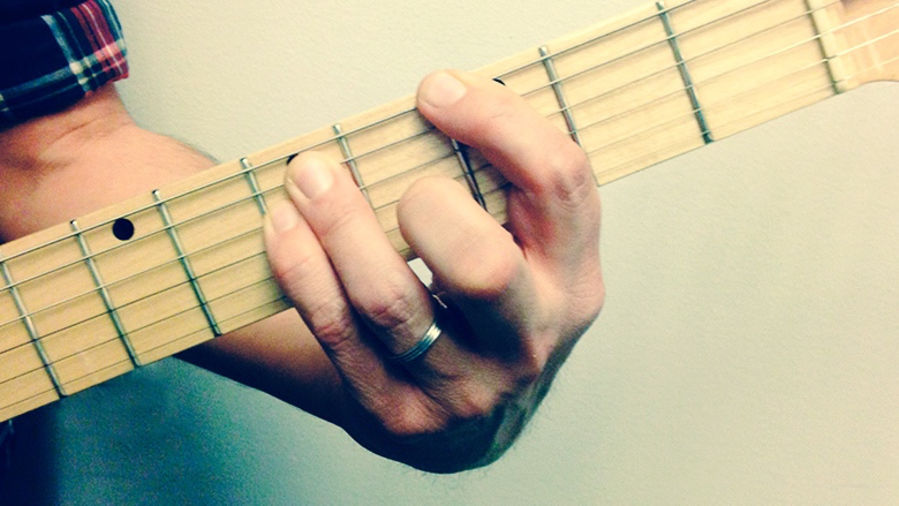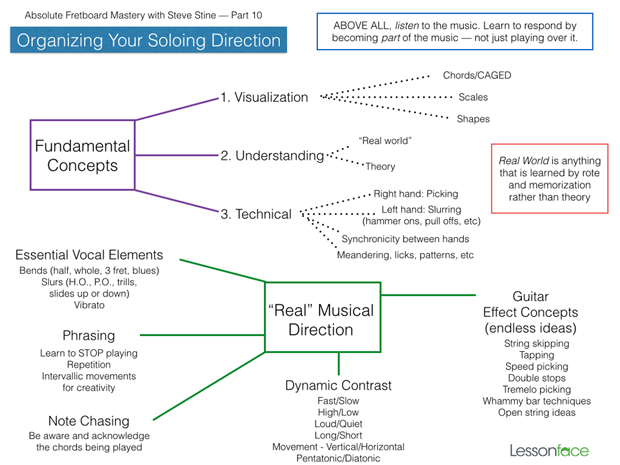Achieving Absolute Fretboard Mastery, Part 10
Learn how to effectively organize and plan your solos.

Hey, guys. Welcome to Part 10 of my Absolute Fretboard Mastery series.
Over the past 10 months, we’ve touched on a heap of theoretical, technical and creative aspects of guitar playing. And if you’ve followed the series from the very beginning (If you haven’t, start here and be sure to check out all the previous parts of this lesson).
Which brings us to today’s lesson! You see, it’s always great to acquire knowledge, but that knowledge becomes redundant if you don’t know how to apply it. And sometimes when it comes to guitar playing, a massive body of knowledge can be confusing to draw from and organize when creating music.
So in this week’s lesson, I want to focus on teaching you how to effectively organize and plan your solos. By the end of this lesson, you’ll have a visual map that will cover all the things we’ve learned and how we’re going to organize them when writing solos.
Category 1: Fundamental Concepts
If you take some of the greatest guitarists of our time, the one thing they have in common is that they know their fretboard like the back of their hand. If you look at a guitarist like Joe Satriani or Steve Vai or Yngwie Malmsteen, you’ll notice how their hands just seem to dance across the fretboard without looking at it.
So the first thing I want you to focus on is your visual mastery of the fretboard. So far, we’ve learned things like the notes across our fretboard, the pentatonic shapes, pentatonic expansions and CAGED chord shapes. When you look down at your fretboard, ask yourself if you can see all these theories in visual layers. Be brutally honest here and address any visual “black holes” you might have. For example, if you can’t immediately see all your pentatonic shapes when you look down at your fretboard, revisit that knowledge area and relearn in until you’re absolutely sure of it.
All the latest guitar news, interviews, lessons, reviews, deals and more, direct to your inbox!
Category 2: Understanding Grouping
The next category I want you to think about is how each of these theories we’ve learned correlate to each other. For example, when you play a pentatonic scale, do you understand the notes you’re playing? Do you understand how these notes correlate to the chords you’re playing over? Do you instantly know which key you’re playing in?
The beauty of learning these various aspects of guitar theory is that in the end it all comes together to form a beautiful mosaic of sorts that makes your understanding of the instrument so much more holistic.
Category 3: Technical Ability
Sometimes when I talk about technical ability, I hear things like, "Oh, you don’t need to play fast to sound good,” or “You can’t be good unless you can play fast.” But here’s the thing: I’m not here to tell you that you need to play fast or you need to play slow.
Instead, all I’m going to tell you is to not limit yourself in any technical aspect. Don’t shy away from a particular aspect of technique just because you think it fits into one category or style of playing. Learn and master as broad an array of techniques that you can so that when you do create your own music, you don’t ever have a disconnect with what you want to play and your actual ability to play it.
Category 4: Real Music Direction
You know, at the end of the day, it’s not the theoretical understanding or the techniques that make a great guitar player. It’s the human element of their playing. So with this category, the first thing I want you to focus on is the vocal techniques you can use in your guitar playing. What we’re really doing as guitarists is making our instruments sing. So start learning to use things like bends, vibrato, hammer-ons, pull-offs and slides that enhance the vocal element of your playing.
The second aspect I want you to focus on in this category is your phrasing. To understand the importance of phrasing, think about how we speak. If you spoke each and every word at a consistent pace, with no stops or pauses, imagine how monotonous it would sound.
It’s the same with your playing. When playing guitar, you need to know when to speed up, when to slow down and most importantly, when to stop. Another important aspect of phrasing I want you to pay attention to is repetition. Whether it’s a melody or a rhythm, repetition gives listeners an opportunity to latch onto the music you are playing. I’m not saying you should play the same notes and rhythms over and over again, but create passages with repetition that act as hooks.
Next we have intervallic playing. A common mistake a lot of beginner players make is they restrict their playing to simply going up and down a scale. But there’s hardly any musical depth or excitement in this. Instead, focus on strengthening your ability to utilize intervals. Instead of going from tone to tone, try skipping over a couple of tones once in a while. It’ll free up your melodic sensibility a whole lot more and it will make your playing so much more interesting.

Up next, note chasing and chord chasing. If you listen to singers, you know they don’t just sing random notes over any and every chord. The notes they sing tend to correlate to the chords they’re singing over. And this is exactly what we learned with chord chasing and note chasing. I’m not saying that whatever melodies you play on the guitar need to always use this principle, but say you’re soloing in the key of A minor and the chord moves to G, it makes musical sense to incorporate notes in the scale that correlate with this chord.
Dynamic contrast is also a very important aspect of real music direction. If you listen to players like David Gilmour or Gary Moore, you’ll notice how they seem to spend so much attention to the dynamics of their playing. You’ll notice how they play some notes hard and some notes soft, or how they sometimes play really loud before switching to playing really softly. This is what adds the human aspect to their playing.
So try to shake things up. If you’ve been going fast, go slow, or stop playing altogether. Think of the story that you’re trying to tell through your solos and use your dynamics to make listeners feel this story.
Last but not least, we have the guitar effects element of your playing. Playing guitar isn’t just about cranking up the distortion and just playing licks all day. Listen to some of your favorite guitarists and learn how they use their effects to augment whatever solos they are playing on their guitar. And then start experimenting yourself. In this day and age, there are so many incredible effects we can use to add aspects to our guitar playing that we couldn’t have even imagined 10 years ago.
So, what do I want you to take away from today’s lesson? I want you to understand that the real job of a guitar player is to complement and help carry whatever greater musical idea they are a part of at any given moment.
If you are a player who tries to incorporate every scale, every technique and every lick you know when playing, you’re not doing justice to whatever bigger musical idea you are a part of. Instead, focus on really listening to whatever music you are playing along with, understanding what it needs from you as a guitarist, and using this categorization to work on delivering that.
Steve Stine is a longtime and sought-after guitar teacher who is professor of Modern Guitar Studies at North Dakota State University. Over the last 30 years, he has taught thousands of students, including established touring musicians, and released numerous video guitar lesson courses via established publishers. A resident of Fargo, North Dakota, today he is more accessible than ever before through the convenience of live online guitar lessons at Lessonface.com.
